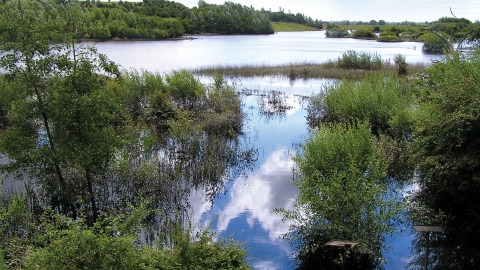Due to on going works in the area, parking and access to Thorpe Marsh nature reserve is currently very limited.
You may prefer to visit one of our other local reserves instead: Potteric Carr Nature Reserve or Fen Carr Nature Reserve.

Thorpe Marsh Nature Reserve
Know before you go
Dogs
Please keep all dogs to the bridle path only.
When to visit
Opening times
Open at all timesBest time to visit
March to September
About
On the east bank of the River Don floodplain, Thorpe Marsh nature reserve is an area of lowland grassland with a large lake and small patches of woodland and scrub with oak, ash, hawthorn, blackthorn, willow, birch, and, in the wetter areas, alder. The woodland gives many feeding and nesting opportunities for great spotted woodpeckers, long-tailed and willow tits, treecreepers and tawny owls, among others.
The large fields are home to many flowers. Reedholme and Cockshaw Fields have centuries-old ridge and furrow corrugations with plants not now commonly seen in pastures - species such as adder's tongue fern, pepper saxifrage, devil's bit scabious, great burnet and common figwort.
The disused railway embankments, open in parts and wooded in others, give excellent views over the site and support many plants such as red and white campions, lady's bedstraw and broad-leaved helleborine and many insects and breeding birds.
Hedgerows of varying ages provide food, cover and highways for insects, birds, mammals and grass snakes.
Thorpe Mere is the largest of the water bodies. Grey heron, geese and ducks are regulars but waders like oystercatcher, green sandpiper and redshank are often seen here. In winter wigeon and goosander are regulars. At the Mere Scrape little grebe, moorhen, coot and mallard usually breed and water rail are shy visitors too. Applehurst Pond is also worth watching with good views of water birds.
Seasonal highlights
- Spring: Plants - Cuckooflower; Common spotted orchid; Invertabrates - Orange-tip; Birds - Cuckoo; Blackcap
- Summer: Invertabrates - Cinnabar moth; Birds - Kingfisher
- Autumn: Invertrabrates - Comma; Migrant hawker; Common darter; Birds - Teal
- Winter: Birds - Wigeon; Long-eared owl; Fieldfare; Lesser repoll; Bullfinch
History
The land here was owned by the power station that used to stand just to the east, and the land has been managed by Yorkshire Wildlife Trust since before the power station closed. There is an old railway embankment that bisects the site, and the East Coast Mainline runs along the western edge, a clear link to the history of Doncaster. The Ea Beck is to the south. The island of land between all these areas meant it was never intensively farmed, and ridge and furrow landforms can still be seen in the fields. The land was purchased by the Central Electricity Generating Board in the 1960s for tipping fly ash. This has meant that a great mix of plant species have flourished.
Directions
Public transport
The nearest bus service is the Doncaster to Barnby Dun service alighting adjacent to the to the Sheffield and South Yorkshire Navigation at Madam Lane walking back over the canal lift bridge along Forstead Lane. This is about a mile long walk to Marsh Lane plus the half hour walk mentioned in the article.
By car
The nature reserve entrance is at the Norwood Gate on Fordstead Lane, near the Norwood pumping station. Visitors may approach via Arksey or Barnby Dun. The public bridleway to the south of the ash-tip leads to the nature reserve and its permissive footpaths.




